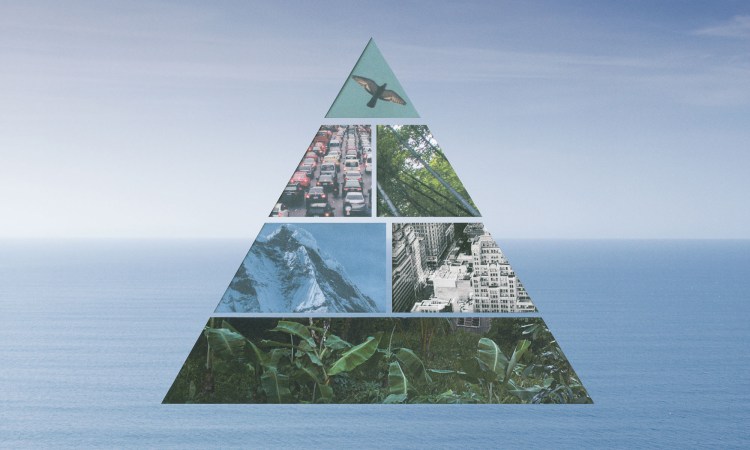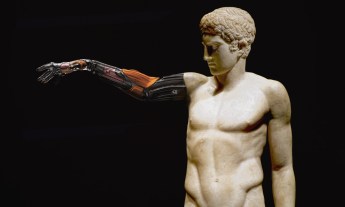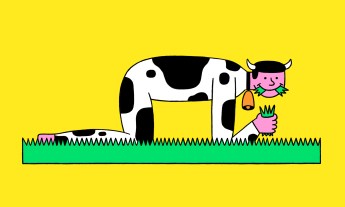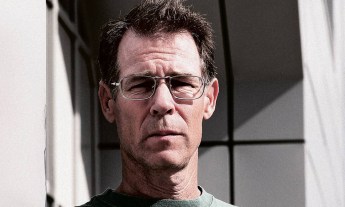
For most of us, the job of taking care of the planet is very definitely the responsibility of Someone Else. We might have thoughts, we might have standards, we might even have a composting habit, but we more than likely hope and expect that the trained professionals have got this under control. One problem, of course, is that those who are trained to look after the world often come from many different disciplines; they might be working on the same problem simultaneously from two very different points of view that clash.
That has to change, says landscape architect and TED Fellow Bradley Cantrell in this epic conversation with ecologist Erle Ellis. Below, the pair talk about how their two professions can understand each other and work together in surprising ways to build a sustainable future for wolves, rhinos, butterflies … and us.
Bradley Cantrell: You and I are very deep in our own professions, and in some ways this conversation almost requires a preamble to make sure that everyone’s on the same page.
Erle Ellis: I think it’s a pretty rare thing to have this level of contact, honestly.
Cantrell: For both of us, changes in our professions are what allow us to engage now. For landscape architects, we’re realizing that the issues affecting the things we work with — site and vegetation and soil — are just byproducts of much larger systems of ecology. We now have tools to see the world at a larger scale: aerial photography, the global positioning system, GIS, and computer simulations.
Ellis: Yeah, a lot of this has come from new technologies that enable us to see the whole earth. In ecology, research sites often are quite small, in fact some of them are almost embarrassingly small, square meters and that sort of thing. But anybody now can see that there’s a broader context. A lot of ecologists, especially young ecologists who have been trained in these new techniques, they take it as a given that you have to consider how the landscape fits into a spatial context, a historical context, and for many, and me in particular, the human context. As soon as you zoom out, you start realizing that none of the places we study are isolated from humans, and that’s pretty striking to a lot of ecologists, because the classic view of getting your ecology PhD is you’d find some relatively undisturbed site to study in detail.
“Humans change things intentionally, but half the time we don’t quite get what we intend.” Erle Ellis
Cantrell: There’s something in the purity of how we once viewed “ecology” and “nature.” But suddenly we are no longer on the outside. We are active agents within these ecologies. We are altering them. Sometimes people say that designers have too much hubris to think we can design the planet. But if we don’t take on that role, we’re only dealing with a profession that’s about remediation. We’re just cleaning up our messes over and over again.
Ellis: This gets to the heart of an important question, which is: How do humans fit into ecology? The classic ecological science view is that humans are separate, that social scientists and those who deal with humanity can do their “human” thing on one side, while ecologists do the rest, keeping “nature” as a distinct subject of ecology. But it quickly becomes clear that Earth’s ecologies have already been transformed by humans. In fact, the recent proposal to recognize an Anthropocene epoch argues that humans are a transformative global force on the entire earth system, pushing it in brand-new directions. Humans change things intentionally, but half the time we don’t quite get what we intend. We don’t intend to have pollution or unwanted species showing up. These are unintended consequences. So we need to look more broadly at everything that happens or could happen when we change things. Designing for humans and letting the rest just kind of happen isn’t good enough, because we will get results we won’t be so happy with. The future ecology of the earth is going to depend on the intentions of the people who reshape it.
Cantrell: A lot of this comes down to ideas about control. Typically we implement a sense of control by taking complex systems and abstracting them — and typically, we get unintended byproducts from that. Responsive design technologies — the ability to model, sense, monitor and respond — set up a new form of design, one where we decenter humanity, and we put ourselves level with a whole host of other systems. We begin to imagine new goals for these systems. The questions for me — what goals do we set to imagine a new ecology? What makes a successful, novel ecosystem?
Ellis: Well, as soon as you start talking about human intention, you have to ask whose intention you’re talking about. There’s not just one player in these things; the stakeholders are numerous. Some people want to see one type of ecology, others want to see another. Do future generations want the ecologies we’re preparing for them? Humans are a permanent force; the idea that we can fix a problem and then walk away is the exact opposite of what we need to be thinking. Instead, we’re acting on something that’s in motion, it’s going to continue to be in motion, and we’re going to continue to interact with it.
“Design becomes an ongoing layering process, as opposed to a proposal that says, ‘this is what we want this to be’ and then we just try to maintain the status quo.” Bradley Cantrell
We’re always going to have to monitor and repair and rebuild. But design can go so much further than that. With design, you’re trying to visualize things that don’t exist. You’re asking: What can we do that’s better than what we’re already doing? It’s a visionary step beyond simply solving a set problem and moving on. Could we have wildlife that thrives in a city that also does well for the people who live there? A lot of people think of these as two separate issues, but in my view, you can’t have nature on one side and humans on the other. Everywhere we go, we’re having this powerful interaction. So the question for me is, how can we design interactions better for both humans and nonhumans? A classic example of this is bringing back birds of prey and giving them roosts in stadiums. Some of these birds were extremely endangered, but they’re blooming up there. There’s tons of pigeons to eat; they’re happy, we’re happy. It is possible to have people and wildlife live together successfully. The problem is that too often we’re only thinking in one dimension at a time.
Cantrell: We can think of the environment itself as an open prototyping platform or laboratory. We nudge it, push it in certain directions and add in more complexity as we start to develop these experiments. So, say we’re aiming for species diversity, as we overlay more complexity into the environment, then novelty forms out of it. In some sense, design becomes an ongoing layering process, as opposed to a proposal that says, “this is what we want this to be” and then we just try to maintain the status quo based on what we envisioned 10 or 15 years ago.
Ellis: The problem is that the world is changing so fast. Hopefully we’ll be able to steer away from the worst of global climate change, but there’s no doubt we’re going to have a lot of it, and species are going to have to move. Some species are genuinely threatened, and anything that can be done to keep them around must be done. But many species currently native in one place are no longer going to be native there. That’s challenging for classically trained, professionally employed conservation ecologists, who are now in situations where species are no longer viable in some of the places where their habitat has been protected. They need to consider the reality of those species moving to other places — and they also need to think about the new species that are showing up. The idea that they can keep things constant with the resources they have in a changing environment is not feasible economically. Even with their wildest dreams fulfilled in terms of funding, they can’t maintain the status quo.
Cantrell: We end up with this weird oasis in the middle of some other climate that supports one specific species.
Ellis: In Dubai, they made a ski resort in the desert. That’s almost what it would take in some of these areas, the environments are warming and changing so much. And that’s just talking about the external force of climate! Other forces are equally in play, like transport of species around the world and other effects of people’s lifestyles and use of land for agriculture. These things have all sorts of secondary ecological effects. Sustaining wildlife within protected environments can be almost impossible. So you have to think about the visions for keeping these wildlife viable with change.
Cantrell: I think we can agree that conservation ecology is well intentioned — it’s framed around maintaining species diversity and maintaining native species. But it might be short-sighted.
Ellis: In the past, you could say it was taking the long view. The thinking was, the human world moved so quickly, it didn’t consider the needs of the natural world. But now it’s become obvious that it’s essentially impossible to create a static world for non-human species to live in. So yes, it has become essentially a backward-looking approach. For a time, I think practitioners felt threatened and tried to keep things the same. But at this point, I think a lot of people have realized that it’s no longer a matter of perspective or theory about whether protected areas need to change or whether wildlife species need to move. Now it’s obvious that this is the practical reality. In general, I think ecologists are aware that the status quo isn’t going to be successful and new strategies are needed.
Cantrell: Landscape architects have often taken on a design mentality that is about separating humanity and natural systems, to provide a separate habitat for species. But whenever we begin to alter ecological systems, it brings up a new question about our ethical stance. There’s a new and important conversation for designers and ecologists to have: What makes a working ecological system? What constitutes a working relationship between human beings and flora and fauna?
Ellis: For a lot of ecologists, there are essentially only two options. For environments that appear uninfluenced by humans, the goal is “protect this natural place from humans,” but for human-altered environments, anything goes. The concept of novel ecosystems says that things aren’t so simple, that ecosystems can be very useful for wildlife and for humans even when they are not what they were before. Sometimes novel ecosystems are actually desirable. My favorite example of a non-native species sustaining a native species is from near where I am right now in California. The monarch butterfly population has dropped dramatically — and they love eucalyptus. Now California has an awkward relationship with eucalyptus. It’s everywhere, it’s fully established, you could almost say it’s naturalized. For the most part, people like it … but it’s not a native species. Without people, it wouldn’t be here. But this so-called invasive species is sustaining populations of a native species that we’re concerned about. That’s a novel ecosystem: an introduced species becomes almost a keystone species of an ecosystem, and it’s able to sustain a lot of the native wildlife. How should we engage with that? Get rid of the eucalyptus?
“There’s no panacea, there’s no end to the problems — but there doesn’t have to be an end to the vision, either.” Erle Ellis
Cantrell: This is when the conversation between ecology and design actually starts to grow up, because it moves away from the easy answers, that there’s a right and a wrong. Instead, it acknowledges that we need a greater level of analysis and understanding, and a discussion about what we need to achieve.
Ellis: Right. What is our intention here? And when we say “our” or “we,” we have to reach out a bit. There’s lots of “we”’s here. No one group should get to decide over anyone else. In the past, scientists were privileged in that way, by claiming their objective measurement could determine whether a certain path of conservation should be taken. We need to move on from that, and get with the idea that these are choices that shouldn’t be made by just one part of society. We need to engage more of society. Of course, that doesn’t make it easier. It makes it harder. Some of the stakeholders are at war with each other: the developer and the conservation people in the neighborhood see opposite goals for the same place. So how do you bring these folks together to get a satisfying outcome? And then how do you keep people engaged? There are unintended consequences in even the best designs. There’s no panacea, there’s no end to the problems — but there doesn’t have to be an end to the vision, either.
Cantrell: Here’s an interaction with the environment I find fascinating … Let’s talk about the site in southern California where the Colorado River comes in. One portion of it is being diverted to Los Angeles, and another portion is being diverted into the Coachella Aquifer. In many ways, we’re taking an entire river and diverting it in these two different directions. Now we can see that as a huge engineering feat, but we’re also affecting the river system — we’re turning the river off and on –and as a result we’re creating an ecological system downstream. The system is driven by economic interests, but what’s produced is a novel ecosystem that wouldn’t exist anywhere else. We need to advance the way we build these systems so they’re not just taking driven by economics, but also weighing in on the habitat they’re going to create.
Ellis: That makes me think of another example in California. There were two big problems. The first was that wetland habitat for migrating birds was getting limited, and the other was that rice farmers were burning straw to cultivate their paddies — and creating a lot of air pollution problems. A conservation organization came up with the brilliant idea of paying for the cost of irrigation water so that rice farmers could flood their paddies in the wintertime instead. By flooding in winter, the straw rots, and it’s very good for the soil. And the wildlife can now use those habitats in the winter. So you go out there and you might as well be in a wildlife sanctuary. It’s a win-win situation. Yes, it cost money, but it’s a scenario where you get different people who have very different needs at the table and there was this real opportunity for redesign.
Cantrell: It calls for visualization and solutions that are nimble, so when we see things changing in any one direction, we can retune them.
“Wildness is an engineering and design challenge now. Maybe the biggest one. How do you keep humans from manipulating everything?” Erle Ellis
Ellis: Emergent things, things you couldn’t plan for or bake in or predict but they could be important and helpful, those are part of it too. Evolution is part of this. You wouldn’t want to stop the evolution of wildlife, but in some ways, conservation aims to do that, because one of the most powerful forms of evolutionary process is extinction — but for a variety of social reasons, a lot of these extinctions are highly undesirable. I don’t want species to go extinct — well, maybe some species of mosquitoes — but in general, I want species to live on — even those that now require our help to survive, like rhinos. I don’t care if they can’t sustain themselves in human habitats. I want to sustain them anyway, and so that’s an intentionality that we want to bring to a wildlife process. But if we manage them so carefully, at some point you end up domesticating them. They are no longer truly wildlife. When you go to the zoo, you consider that a less satisfying experience than seeing them in the wild, even on TV. The idea they’re out there taking care of themselves is pretty important to us. It’s probably pretty important to them too, so how do you sustain that? That’s really pretty tough, because when these species get to low population levels and the habitats become harder to sustain them in, there’s a real strong tendency to jump in and do what you do with domesticated species.
I just visited Kenya and saw rhino conservation in action, and the black rhinos are so rare and considered so valuable that each individual rhino has a name, a genetic profile, and someone who watches them every day to make sure they’re okay. But they pretty much have to. At the scale of the population and the human interaction, they really do have to watch over them carefully. It’s possible to continue to do that in environments where they’re breeding on their own, but I don’t think they’ve succeeded in that right now. I think they have more or less a proto-domestication process going on here.
That might be a metaphor for designing processes. We want certain outcomes. We want the rhinos around. But we have to do something, an engineering element. But we don’t want to do it at any cost. We don’t want them to end up looking like they’re living in the zoo. We want to still have this emergent possibility of dying unexpectedly, and hopefully population explosions or other unpredictable things happening to them. We want that around. We don’t want them in walls. It’s hard, designing to keep these things going on their own.
Cantrell: Almost like ecological taxidermy.
Ellis: I think it’s more like we make them our pets. I wouldn’t quite use the word taxidermy, but I would say they’re our pets. I love the rhinos. You can’t hang out with them without falling in love with them, they’re such cool creatures. But the idea we’re worried about their extinction in the wild is kind of misplaced. They’re kind of not wild anymore, even if they’re not in the zoo. And I think they could be wilder. I don’t think it’s game over for wildness. Wildness is an engineering and design challenge now. Maybe the biggest one. How do you keep humans from manipulating everything?
Cantrell: It’s almost counterintuitive, right?
Ellis: It’s exactly that. But it’s this creeping domestication out there that is everywhere. My favorite example is the conservation of wolves in Europe. It’s debatable if there are any true wolves within the parts of Europe beyond Siberia, because they’ve bred with dogs, and they continue to breed with dogs even though there’s big efforts to try to prevent them. People who work in this area, they want to keep wolves pretty much wolves genetically. They don’t want them to become dog-wolves. But the fact is, they pretty much are. They’re not sure they have any 100% wolf in Europe anymore. So they’re sustaining these kind of hybridized wolves in one of the most densely populated, one of the most anciently transformed landscapes in the world, Europe, and these wolves have come back. They’ve been able to pull back the wolf populations. They’re more or less out of danger. They still need careful management, but they’re not endangered anymore. But they have to live in this environment with all sorts of forces, and they’re monitored carefully. Their genetics are fairly known, just like breeding any animal. Sustaining them in this environment has proven possible, but there’s this creeping domestication that has become a challenge. They’ve got wolves, and people can live with them, but now they’re changing.
Cantrell: You might start thinking in terms of not falling in love with a single species but building diverse platforms for different species to exist upon. Right? So the goal becomes less about designing something for wolves and rhinos, but instead designing the platform where they could exist, and allowing that platform to evolve.
Featured image by Sacha Vega/TED.












